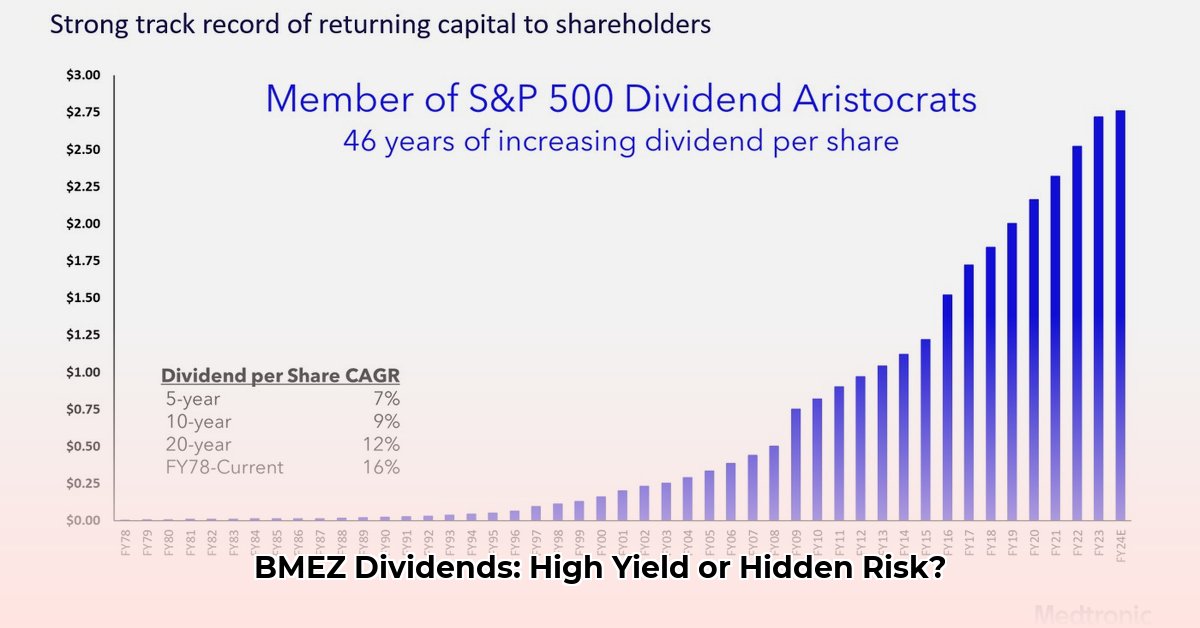
BMEZ stock presents a compelling investment opportunity with its enticing 11.71% dividend yield and impressive 26.55% year-over-year growth. However, this high yield necessitates a cautious approach due to the limited historical data available. This instructional guide reviews the publicly available information, identifies key data gaps, and provides actionable steps for various stakeholders to assess the risk and reward associated with BMEZ dividends. Understanding the limitations of the available data is crucial before making any investment decision.
BMEZ Dividend Data: A Critical Analysis
The current information on BMEZ's dividend history is incomplete, raising significant concerns for potential investors. While the recent high yield and growth are attractive, the absence of crucial data points hampers a thorough assessment. Specifically, the lack of a longer-term dividend history and the missing payout ratio (the percentage of earnings paid out as dividends) significantly limits our ability to assess the sustainability of the current dividend payments. This data deficiency makes accurate risk assessment challenging. Without a clear understanding of how BMEZ has historically managed dividend payments during economic downturns or periods of reduced profitability, we lack crucial insight into its dividend policy resilience.
Key Data Gaps and Their Implications
- Missing Payout Ratio: The absence of the payout ratio prevents a determination of the dividend's sustainability relative to BMEZ's earnings. A high payout ratio, if it were known, would indicate a higher risk of dividend cuts if earnings decline.
- Short Historical Record: A one-year history provides insufficient data to assess the dividend's resilience during various economic cycles. Longer-term data is needed to understand its behaviour through periods of market volatility and economic downturn.
- Lack of Information on Stock Splits: The impact of any past stock splits on the dividend history is unknown, requiring further investigation to accurately assess historical yields.
Actionable Intelligence for Key Stakeholders
This section details actionable steps for different stakeholders to navigate the BMEZ dividend investment landscape effectively.
Income-Seeking Investors
- Access Financial Statements: Obtain BMEZ's financial statements (10-K, quarterly reports) from the company's investor relations website or the SEC's EDGAR database (https://www.sec.gov/edgar/searchedgar/companysearch.html).
- Comparative Analysis: Compare BMEZ's dividend yield and payout ratio (if available) to similar companies in the same sector to assess its competitiveness and potential risks.
- Risk Tolerance Assessment: Use online resources or consult a financial advisor to determine your personal risk tolerance. High-yield investments, by nature, often carry higher risk.
- Performance Monitoring: Regularly monitor BMEZ's financial performance, dividend announcements, and relevant news through reputable financial websites.
Financial Analysts
- Comprehensive Data Gathering: Gather detailed financial data, including income statements, balance sheets, and cash flow statements, from reliable sources.
- Payout Ratio Estimation: Attempt to estimate the payout ratio using available financial information. This requires careful analysis of earnings and dividend payments. Consider using industry averages as a benchmark.
- Sensitivity Analysis: Conduct sensitivity analysis to model the impact of varying earnings levels on the dividend's sustainability.
- Financial Modeling: Develop a financial model to forecast future dividends, incorporating macroeconomic factors and potential economic scenarios.
BMEZ Management
- Enhanced Transparency: Increase transparency in financial reporting to provide investors with a clearer picture of the dividend's financial underpinnings. This includes providing historical data and a clear description of the dividend policy. Consider publishing a detailed annual dividend outlook.
- Sustainable Dividend Policy: Formulate a long-term dividend policy aligned with the company's financial health and long-term growth prospects, ensuring the dividend's long-term sustainability.
- Investor Communication: Establish clear and regular communication channels to keep investors informed about the company's financial performance and dividend policy updates.
Risk Assessment Matrix
The following matrix outlines potential risks and mitigation strategies:
| Risk Factor | Likelihood | Impact | Mitigation Strategy |
|---|---|---|---|
| Unsustainable Dividend Payments | Possibly High | High | Diversification, thorough due diligence, continuous financial monitoring. |
| Market Fluctuations | Moderately Likely | Moderately High | Diversification across asset classes, stop-loss orders, a defined investment plan. |
| Lack of Information | Moderately Likely | Moderately High | Actively seek additional information from BMEZ; use industry benchmarks. |
| Economic Slowdown | Less Likely | High | Diversification, hedging strategies, stress testing your investment strategy. |
Conclusion: A Cautious Approach to BMEZ Dividends
BMEZ's high dividend yield is undeniably attractive; however, the limited historical data and lack of crucial information, such as the payout ratio, necessitate a cautious approach. While the recent dividend growth is encouraging, it's insufficient to definitively assess the long-term sustainability of these payments. Thorough due diligence, diversification, and regular monitoring are crucial for mitigating the inherent risks associated with this investment opportunity. Further disclosure from BMEZ would significantly improve investor confidence and allow for a more accurate risk assessment. Given the current information, a cautiously optimistic stance is recommended pending further clarification.